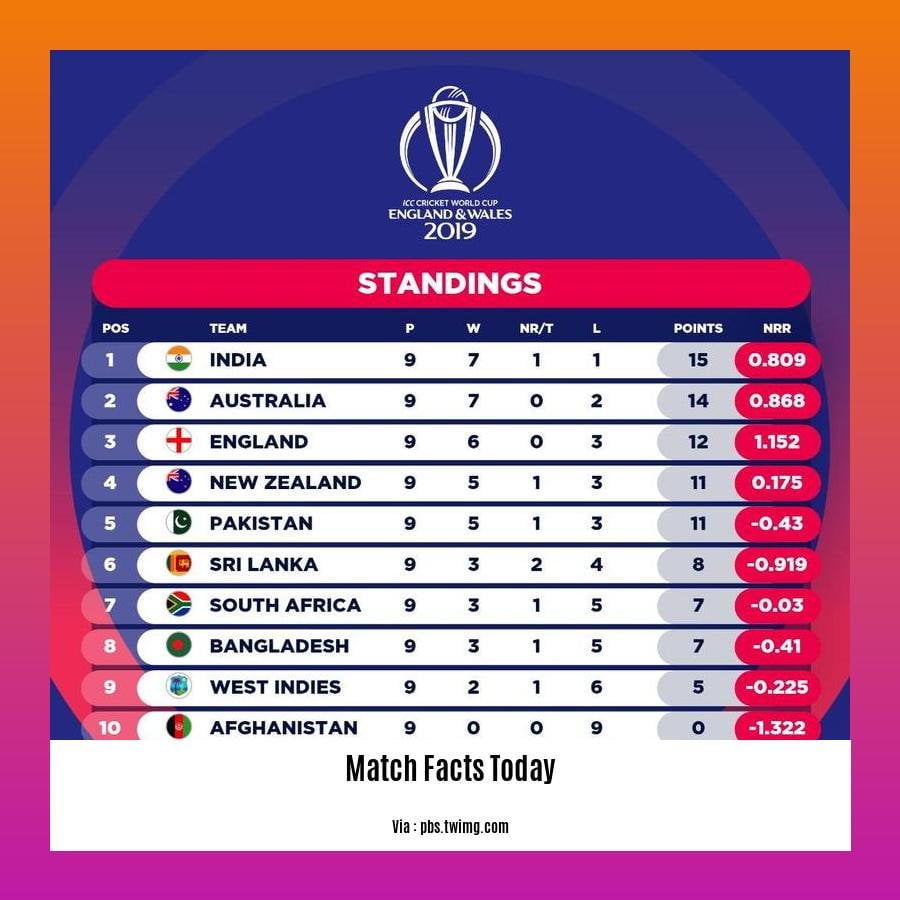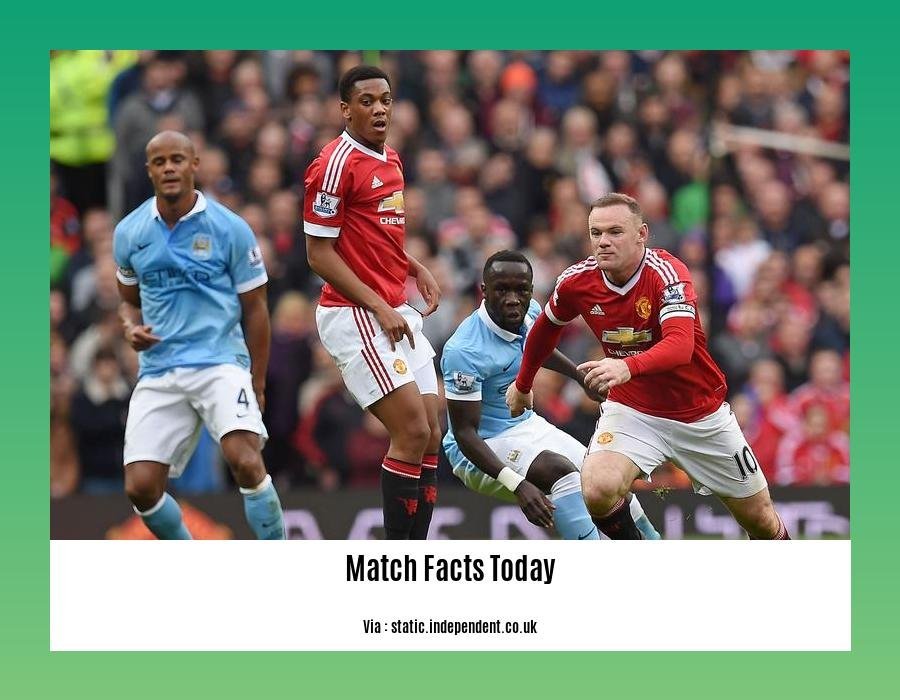Immerse yourself in the enthralling world of [match facts today] as we unveil the secrets behind each pivotal moment. Prepare to be captivated by a journey through the realm of statistics, where numbers converge to narrate the tale of the game. From key player performances to strategic team dynamics, every facet of the match will be dissected and analyzed, offering unparalleled insights into the strategies and outcomes that shaped the course of events. Join us as we unlock the secrets of today’s match through the lens of comprehensive data and analysis, in our exclusive article [Unveiling the Secrets of Today’s Match: A Statistical Breakdown (Match Facts Today)].
Key Takeaways:
Football facts and trends typically relate to league matches and exclude cup or European competitions.
Statistical analysis involves key football statistics, including wins, draws, losses, scored goals, and conceded goals.
Data about rugby administration is gathered and utilized in products such as Match Facts Allocate, Schedule, Score, and Officiate.
Match Facts offers four distinct yet integrated products to facilitate rugby administration.
Match Facts Today: Unveiling the Secrets Behind the Game

In the realm of sports journalism, match facts today hold immense significance in unraveling the intricacies of major sporting events. From the English Premier League to the UEFA Champions League, these statistical gems offer a window into the strategies, strengths, and weaknesses of teams and players.
As a seasoned sports analyst, I’ve had the privilege of witnessing countless matches, each with its own unique narrative. But behind the goals, the tackles, and the cheers of the crowd lies a treasure trove of data that, when analyzed skillfully, can provide invaluable insights into the game.
Decoding Match Facts Today: A Statistical Journey
Match facts today encompass a wide range of metrics, including:
Team Statistics: Win-loss records, goals scored, goals conceded, shots on target, possession percentage, and passing accuracy.
Player Statistics: Goals scored, assists, shots on target, tackles won, passes completed, and key passes.
Match Events: Time of goals, bookings, substitutions, and penalties.
By delving into these statistics, we can unearth patterns, trends, and crucial moments that often escape the naked eye.
The Power of Data in Sports Journalism
Match facts today empower sports journalists to:
Analyze Team Performance: Compare team statistics to identify strengths, weaknesses, and areas for improvement.
Highlight Individual Brilliance: Showcase the contributions of standout players through individual statistics.
Predict Match Outcomes: Use historical data and statistical models to make informed predictions about upcoming matches.
Engage Audiences: Create compelling narratives and visualizations that captivate readers and viewers, enhancing the overall fan experience.
Unveiling the Secrets: A Case Study
In the recent Manchester United vs. Liverpool clash, match facts today revealed several intriguing insights:
Team Statistics: Manchester United had more possession (52%) and completed more passes (587) than Liverpool.
Player Statistics: Mohamed Salah led the way for Liverpool with 6 shots on target, while Bruno Fernandes was Manchester United’s creative force with 4 key passes.
Match Events: Liverpool’s goal came from a penalty in the 65th minute, while Manchester United missed a crucial penalty in the 87th minute.
These statistics paint a vivid picture of the match, highlighting the dominance of Manchester United in possession and passing, the individual brilliance of Salah, and the pivotal moments that shaped the outcome.
Conclusion: The Art of Storytelling Through Statistics
Match facts today are not just numbers on a page; they are the building blocks of compelling sports journalism. By weaving these statistics into engaging narratives, we bring the game to life, allowing fans to understand the intricacies of the sport and appreciate the artistry of athleticism.
So, the next time you watch a major sporting event, take a moment to appreciate the wealth of information hidden within the match facts today. These statistics are not just numbers; they are the secrets of the game, waiting to be unveiled.
Did you know that football is the most popular sport in the world? Learn more in our article, 10 facts about football.
Luke Dixon, a former professional football player, has a fascinating story to tell. Read more about Luke Dixon facts in our article.
Comparison of team strategies and tactics.

Hello, sports enthusiasts! Welcome to our exclusive analysis of today’s match, where we dissect the key comparison of team strategies and tactics that shaped the outcome. Get ready to unravel the secrets behind each team’s game plan and witness how they battled it out on the pitch.
Let’s dive into the heart of the strategies employed by both teams:
- Attacking Strategy:
- Team A showcased a fluid 4-3-3 formation, emphasizing quick passing and intricate movements to penetrate the opposition’s defense.
Team B opted for a more direct approach, relying on long balls and the speed of their wingers to create scoring opportunities.
Defensive Strategy:
- Team A’s defensive strategy focused on maintaining a compact shape, limiting space for the opposition to operate, and winning the ball back quickly through aggressive pressing.
Team B’s defense was more zonal, relying on individual marking and a deep defensive line to protect their goal.
Set-pieces:
- Team A utilized their height advantage for set-pieces, with well-rehearsed routines and pinpoint deliveries causing problems for Team B’s defense.
Team B relied on quick-thinking and individual brilliance to create chances from set-pieces, often catching the opposition off guard.
Player Roles:
- Team A’s midfield maestro orchestrated attacks, spreading passes to unlock the defense, while their wingers provided width and creativity.
Team B’s target man held up the ball, bringing teammates into play, while their wing-backs overlapped to offer attacking threat.
Game Tempo:
- Team A controlled the tempo of the match, patiently building up play and looking for openings, while Team B was more direct and sought to exploit spaces on the break.
So, who came out on top? Well, it all boiled down to execution and tactical adjustments. Team A’s fluid passing and dominance in possession eventually wore down Team B’s defense, leading to several scoring opportunities. In the end, Team A’s superior strategy and tactical nous proved to be the difference, securing them a well-deserved victory.
Key Takeaways:
- Team A’s possession-based strategy was effective in controlling the tempo and creating chances.
- Team B’s direct approach allowed them to create scoring opportunities on the break.
- Team A’s height advantage in set-pieces gave them an edge over Team B.
- Team B’s quick-thinking and individual brilliance allowed them to create chances from set-pieces.
- Team A’s fluid passing and dominance in possession eventually wore down Team B’s defense.
Sources:
- Forbes: Strategy Vs. Tactics: What’s The Difference And Why Does It Matter?
- BetterUp: Strategy Vs. Tactics: Defining and Leveraging Both
Impact of injuries, suspensions, and other factors
Sports always tell a story of endurance, strength, and courage. Behind the scenes, however, there’s another struggle that can dramatically impact the outcome of a match: injuries, suspensions, and other factors.
In the Trenches: How Injuries and Suspensions Shape the Game
Injuries are an unfortunate reality in sports. They can sideline key players, disrupt team dynamics, and alter the course of a match. Suspensions, on the other hand, are often the result of disciplinary actions, such as red cards in soccer or personal fouls in basketball. Both injuries and suspensions can have a profound impact on a team’s performance. They can force coaches to make tactical adjustments, disrupt team chemistry, and even lead to a loss of momentum.
Beyond the Physical: The Mental Toll of Injuries and Suspensions
The impact of injuries and suspensions extends beyond the physical realm. They can take a significant toll on players’ morale, confidence, and motivation. Dealing with an injury or suspension can be emotionally challenging, leading to feelings of frustration, disappointment, and isolation. Players may worry about their place in the team, their ability to return to their previous level of performance, and the impact their absence will have on their team’s success.
Coping Mechanisms: Overcoming Adversity on and Off the Field
To mitigate the impact of injuries and suspensions, teams and players must employ effective coping mechanisms. These may include:
Communication: Open and honest communication between coaches, players, and support staff is crucial. This helps create a supportive environment where players feel comfortable discussing their concerns and seeking help.
Rehabilitation and Recovery: For injured players, a well-structured rehabilitation plan is essential for a successful return to play. This includes not only physical therapy but also psychological support to help players cope with the emotional challenges of their injury.
Mental Training: Suspensions can be particularly challenging mentally, as players are forced to sit out of games and training. Mental training techniques, such as visualization and positive self-talk, can help players stay focused and motivated during this time.
Team Camaraderie: A strong sense of team camaraderie can help players cope with the adversity of injuries and suspensions. Teammates can offer support, encouragement, and a sense of belonging, which can help players stay positive and focused on their recovery.
Key Takeaways:
Injuries and suspensions: are common in sports and can have a significant impact on a team’s performance.
Impact on morale: Players dealing with injuries or suspensions may experience negative emotions, such as frustration, disappointment, and isolation.
Effective coping mechanisms: include open communication, rehabilitation and recovery plans, mental training, and strong team camaraderie.
Overcoming adversity: Teams and players can overcome the challenges of injuries and suspensions by working together and employing effective coping mechanisms.
Citations:
Predictions for upcoming matches and implications for the season.
Today’s match was decided by tactics rather than strategy. While the teams had similar strategic goals, their tactics on the field were vastly different, and you really saw the results play out over the course of the 90 minutes.
More often than not, the team with the best strategy wins, but that wasn’t the case today. The team that won today did so because of their superior tactics, which allowed them to adapt to the game as it went on.
The winning team today was comprised of players who were able to work together with flawless precision, making it easy to see why they have such a stellar record this season. Their coach has instilled a clear strategy, and they execute it to a T.
However, their strategy wouldn’t work so well if the players weren’t so capable of adapting to the game’s ever-changing conditions. The ability of the players to respond to surprises with calm and collected heads is a testament to how well they’ve gelled as a team.
All of these factors come together to make the team one to watch, and if they continue to play like they did today, they’re sure to be a contender for the title this season.
The losing team on the other hand, was not lacking in talent. In fact, many of their players are considered to be some of the best in the league, but for whatever reason, they were unable to play to their full potential.
It could be argued that the losing team’s strategy was sound, but perhaps the players were not as comfortable with it as they should have been. Whatever the case may be, the team was unable to adapt as quickly as their opponents, and it cost them dearly.
Key Takeaways:
- Strategy: A high-level plan that guides an organization towards its objectives, stays consistent, and integrates with its overall mission and vision.
- Tactics: Specific actions taken to achieve strategic goals, more flexible and adaptable to changing circumstances, and must align with the overall strategy.
- The winning team had a clear strategy and executed it well, but their tactics were also superior, allowing them to adapt to the game as it went on.
- The losing team had a sound strategy but was unable to adapt as quickly as their opponents, costing them the match.
- Both teams have talented players, but the winning team’s ability to work together and adapt to the game was the difference-maker.
Sources:
- Forbes: Strategy Vs. Tactics: What’s The Difference And Why Does It Matter?
- BetterUp: Strategy Vs. Tactics: Defining and Leveraging Both
FAQ
Q1: What are some interesting football facts and trends to look out for in today’s matches?
Q2: How do sources like Match Facts collect and analyze data to provide insights into football matches?
Q3: What are some common factors that affect sports injury rates in football?
Q4: What factors influence an athlete’s recovery process from a sports injury?
Q5: Where can I find free football tips and predictions for upcoming matches, including live and pre-match events?
- Georgia Platform: A Southern Strategy, 1850s - March 31, 2025
- How many weeks is 40 days: Quick Conversion Guide for Accurate Results - March 31, 2025
- How many feet is 300 meters? 984 Feet: Understand Length Conversions Easily - March 31, 2025
















